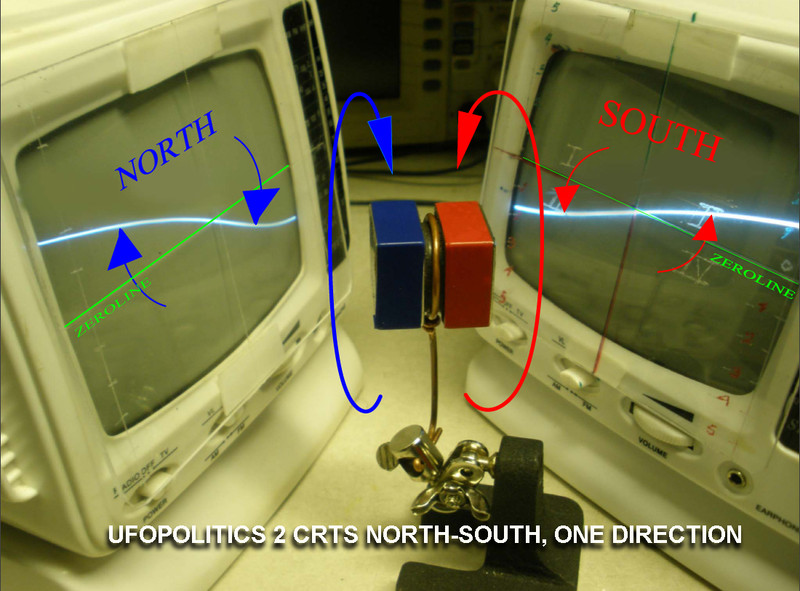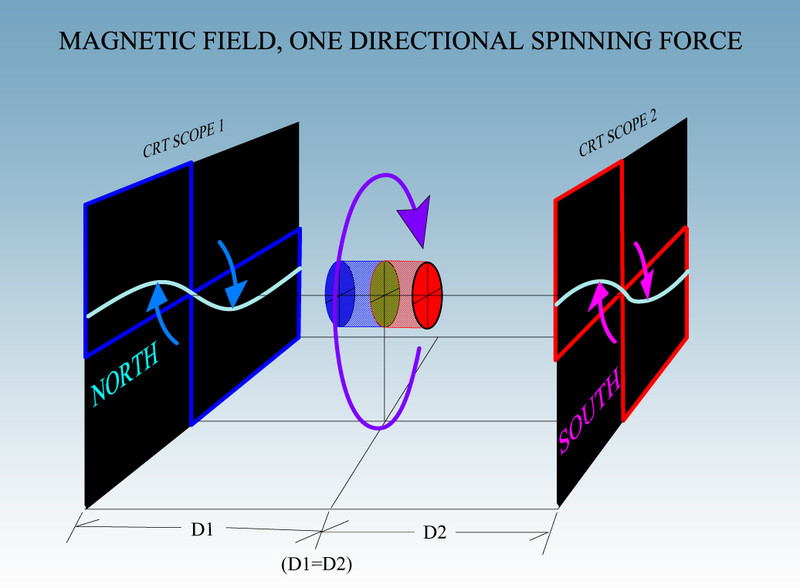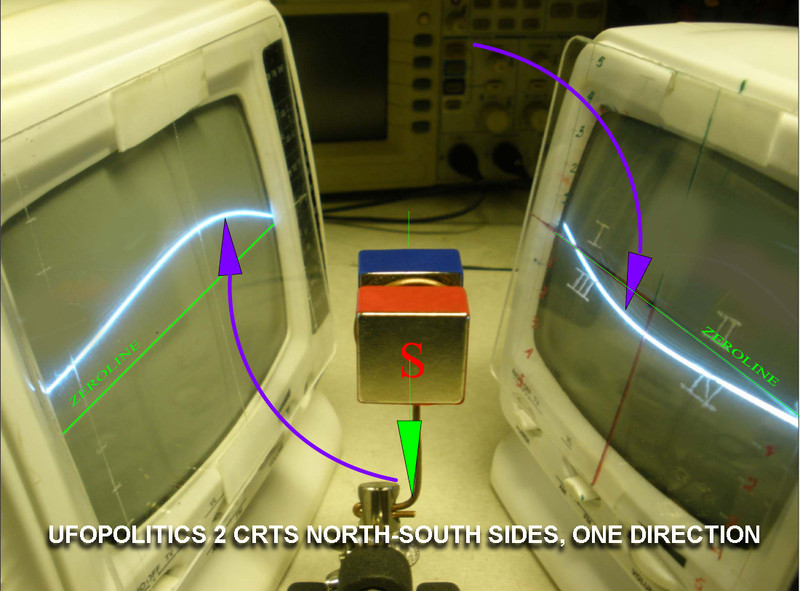Static fields
Hello Gambeir,
Here are a few interesting answers to a question.
Above quotes from: https://www.quora.com/Does-a-static-...magnetic-field
When the fellow doing your experiment bought the magnet, it came with the magnetic field (static, nonmoving relative to the magnet). He then places the magnet, and its static field into the tank. The magnetic field in and around the magnet may have been altered slightly due to the metal at the base and the permeability of the liquid, but is again static. Once charges begin to move in the static magnetic field, Lorentz forces are imparted on those charges. The charges had an initial motion upwards and the magnetic field causes a circular motion, together appearing as a upward moving helix.
Of course there is a reaction force on the magnetic field and hence the magnet, but the friction at the magnet base prevents counter-rotation of the magnet. This is no different than a motor having a permanent magnet frame (stator) and a wound armature (rotor). The magnets in the frame establish a static magnetic field in which the armature carries charges as current, perpendicular to the field. The resulting forces on the moving charges cause the torque, relative rotor to stator. That's why the motor stator will have a flange or mounting bracket; to keep the magnetic field static (stationary).
So what you witness in the experiment is simple electric motor action.
From Wikipedia, magnetic field.
From:
https://www.icnirp.org/en/frequencie...-hz/index.html
From: Electromagnetic Fields: 8. Static magnetic fields like those used in medical imaging
Regards,
bi
Hello Gambeir,
Here are a few interesting answers to a question.
Does a static electric interact with a magnetic field?
Sure.
They interact, or better said, they combine to produce a flow of energy. There is no flow of energy in a static field by itself. When we combine the fields, the energy flow per unit area is given by the Poynting vector:
The E and H are respectively the electric and magnetic field intensities and the Poynting vector, S, is sometimes symbolized by P or N.
Et Ceteras
The fields do not alter each other. That is, if at some point we have an electrostatic field and then overlay a magnetostatic field, the field values of each field remains unaffected by the existence of the other field.
We cannot uniquely define electric and magnetic fields at a point anyway, as different observers in different reference frames will disagree on these field values. This is a fundamental consequence of relativity.
1.4k Views ·
Yes, sort of. The fields do not change each other, but when there is a static magnetic field from one source and a static electric field from another source, the combined electromagnetic field stores angular momentum that would not be stored in either field alone.
To understand this, start with the magnet firmly connected to the lab floor at point (0,0,0) and the electric source far away. As you bring the electric source into the vicinity of the magnet, the electric source experiences a small sideways force due its velocity and the magnetic field. If you counteract this force, then you are providing a torque which, applied over time, causes an angular momentum. When you finish moving the source and attach it firmly to the floor, nothing is moving. The angular momentum has to go somewhere and that somewhere is the electromagnetic field.
243 Views
Static electric fields do not interact with static magnetic fields. This is why these two fields were considered unrelated phenomena in the early 1800's, until Faraday discovered the appearance of an electric field when a magnetic field changes in time. Only when the sources of the fields, i.e. electrostatic charges for the electric field or constant-current loops for the magnetic fields are in motion, these sources interact with the static field. The term "interact" means that the moving charges or moving currents feel a force.
1.5k Views ·
Sure.
They interact, or better said, they combine to produce a flow of energy. There is no flow of energy in a static field by itself. When we combine the fields, the energy flow per unit area is given by the Poynting vector:
The E and H are respectively the electric and magnetic field intensities and the Poynting vector, S, is sometimes symbolized by P or N.
Et Ceteras
The fields do not alter each other. That is, if at some point we have an electrostatic field and then overlay a magnetostatic field, the field values of each field remains unaffected by the existence of the other field.
We cannot uniquely define electric and magnetic fields at a point anyway, as different observers in different reference frames will disagree on these field values. This is a fundamental consequence of relativity.
1.4k Views ·
Yes, sort of. The fields do not change each other, but when there is a static magnetic field from one source and a static electric field from another source, the combined electromagnetic field stores angular momentum that would not be stored in either field alone.
To understand this, start with the magnet firmly connected to the lab floor at point (0,0,0) and the electric source far away. As you bring the electric source into the vicinity of the magnet, the electric source experiences a small sideways force due its velocity and the magnetic field. If you counteract this force, then you are providing a torque which, applied over time, causes an angular momentum. When you finish moving the source and attach it firmly to the floor, nothing is moving. The angular momentum has to go somewhere and that somewhere is the electromagnetic field.
243 Views
Static electric fields do not interact with static magnetic fields. This is why these two fields were considered unrelated phenomena in the early 1800's, until Faraday discovered the appearance of an electric field when a magnetic field changes in time. Only when the sources of the fields, i.e. electrostatic charges for the electric field or constant-current loops for the magnetic fields are in motion, these sources interact with the static field. The term "interact" means that the moving charges or moving currents feel a force.
1.5k Views ·
When the fellow doing your experiment bought the magnet, it came with the magnetic field (static, nonmoving relative to the magnet). He then places the magnet, and its static field into the tank. The magnetic field in and around the magnet may have been altered slightly due to the metal at the base and the permeability of the liquid, but is again static. Once charges begin to move in the static magnetic field, Lorentz forces are imparted on those charges. The charges had an initial motion upwards and the magnetic field causes a circular motion, together appearing as a upward moving helix.
Of course there is a reaction force on the magnetic field and hence the magnet, but the friction at the magnet base prevents counter-rotation of the magnet. This is no different than a motor having a permanent magnet frame (stator) and a wound armature (rotor). The magnets in the frame establish a static magnetic field in which the armature carries charges as current, perpendicular to the field. The resulting forces on the moving charges cause the torque, relative rotor to stator. That's why the motor stator will have a flange or mounting bracket; to keep the magnetic field static (stationary).
So what you witness in the experiment is simple electric motor action.
When a charged particle moves in a static magnetic field, it traces a helical path in which the helix axis is parallel to the magnetic field, and in which the speed of the .
0 Hz
Characteristics of the field and its use
Static magnetic fields are constant fields, which do not change in intensity or direction over time, in contrast to low and high frequency alternating fields. Hence, they have a frequency of 0 Hz. They exert an attracting force on metallic objects containing, for example, iron, nickel or cobalt, and so magnets are commonly used for this purpose. In nature, the geomagnetic field of the earth exerts a force from south to north that allows, for example, the operation of a compass. Much stronger fields are generated by some types of industrial and medical equipment, such as in Medical Resonance Imaging (MRI) devices.
The strength of a static magnetic flux density is expressed in tesla (T) or in some countries in gauss (G). The strength of the natural geomagnetic field varies from about 30 to 70 µT (1 µT is 10-6 T). Household magnets have strengths in the order of several tens of millitesla (1 mT = 10-3 T). By contrast, the fields of MRI equipment vary from between 1.5 to up to as much as 10 T.
Characteristics of the field and its use
Static magnetic fields are constant fields, which do not change in intensity or direction over time, in contrast to low and high frequency alternating fields. Hence, they have a frequency of 0 Hz. They exert an attracting force on metallic objects containing, for example, iron, nickel or cobalt, and so magnets are commonly used for this purpose. In nature, the geomagnetic field of the earth exerts a force from south to north that allows, for example, the operation of a compass. Much stronger fields are generated by some types of industrial and medical equipment, such as in Medical Resonance Imaging (MRI) devices.
The strength of a static magnetic flux density is expressed in tesla (T) or in some countries in gauss (G). The strength of the natural geomagnetic field varies from about 30 to 70 µT (1 µT is 10-6 T). Household magnets have strengths in the order of several tens of millitesla (1 mT = 10-3 T). By contrast, the fields of MRI equipment vary from between 1.5 to up to as much as 10 T.
https://www.icnirp.org/en/frequencie...-hz/index.html
MRI scanners use static magnetic fields
Credit: Kasuga Huang
A magnetic field is a force field created by a magnet or as a consequence of the movement of the charges (flow of electricity). The magnitude (intensity) of a magnetic field is usually measured in Tesla (T or mT).
Static magnetic fields do not vary over time, and as such do not have a frequency (0 Hz). Examples are the fields generated by a permanent magnet or the Earth’s magnetic field.
Credit: Kasuga Huang
A magnetic field is a force field created by a magnet or as a consequence of the movement of the charges (flow of electricity). The magnitude (intensity) of a magnetic field is usually measured in Tesla (T or mT).
Static magnetic fields do not vary over time, and as such do not have a frequency (0 Hz). Examples are the fields generated by a permanent magnet or the Earth’s magnetic field.
Regards,
bi




 :
:

 ) that:
) that:
 ) have two hemispheres? why our heart has two hemispheres why all spores have two hemispheres? why why why?...because all are magnetic dipole manifestations, thus two hemispheres of condensed energy.
) have two hemispheres? why our heart has two hemispheres why all spores have two hemispheres? why why why?...because all are magnetic dipole manifestations, thus two hemispheres of condensed energy.
Comment